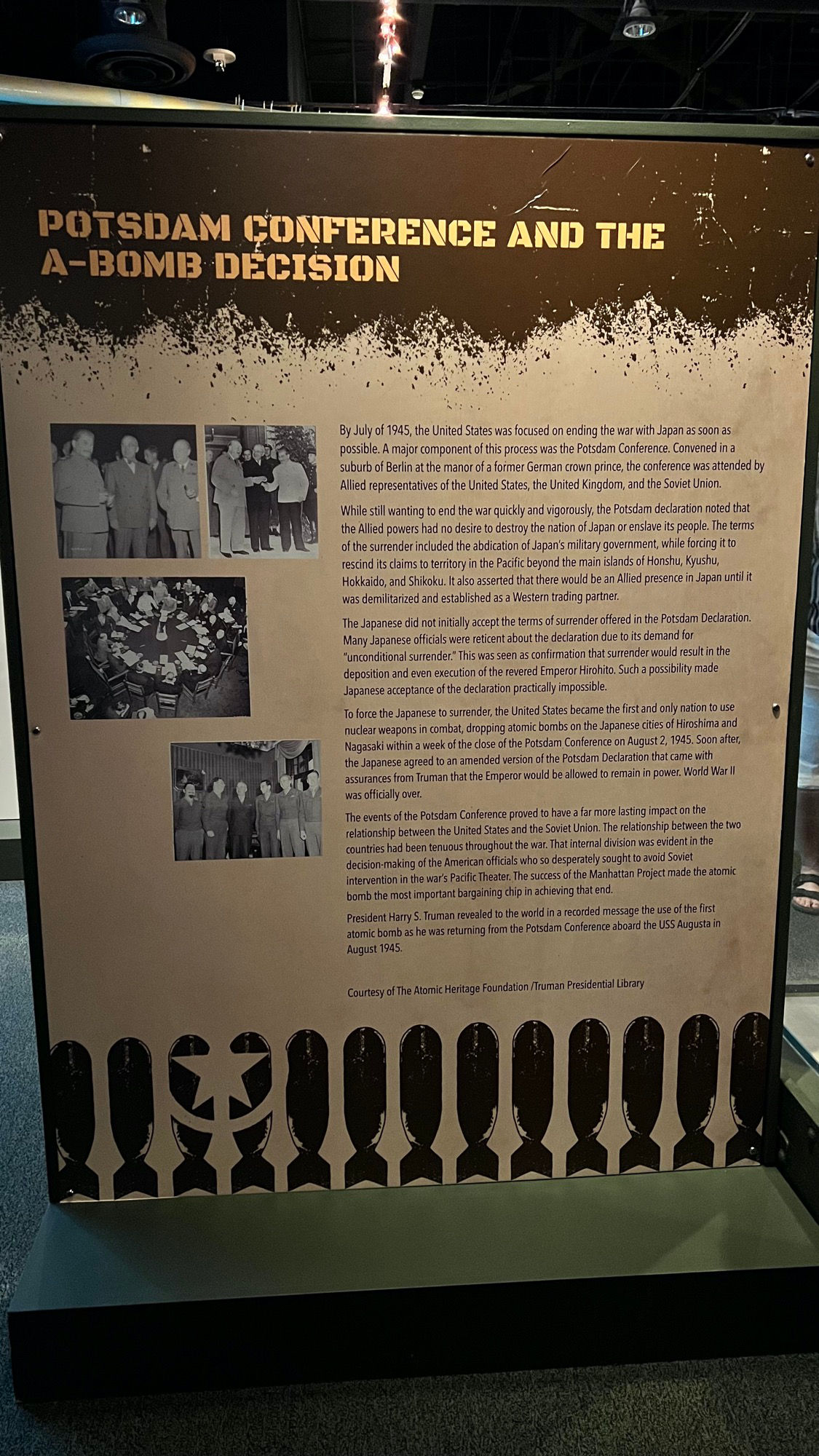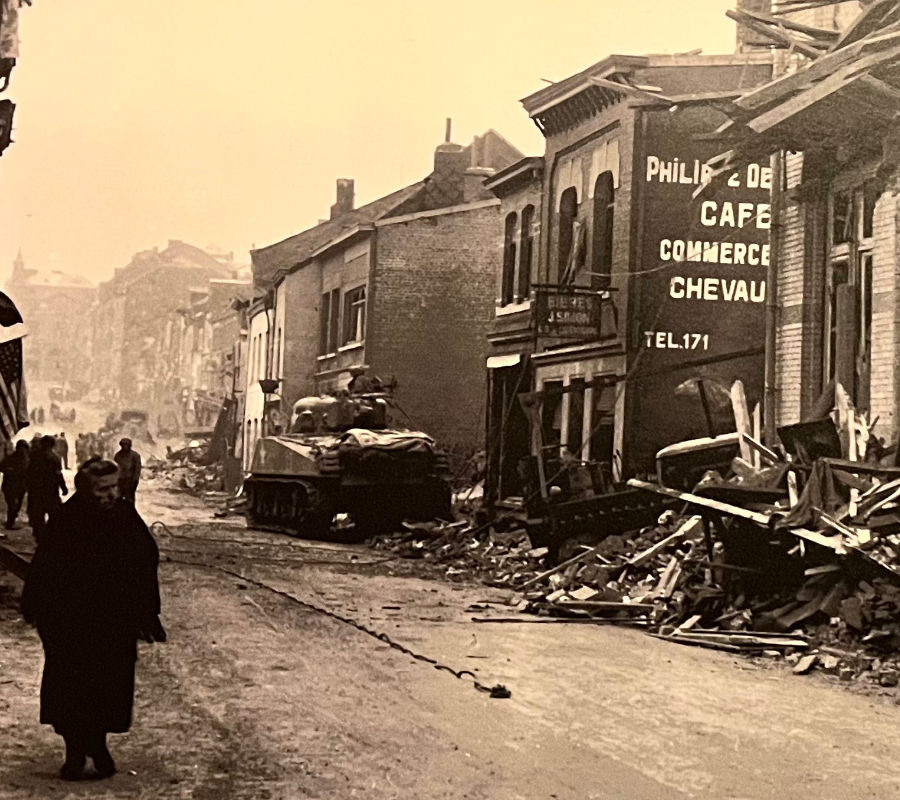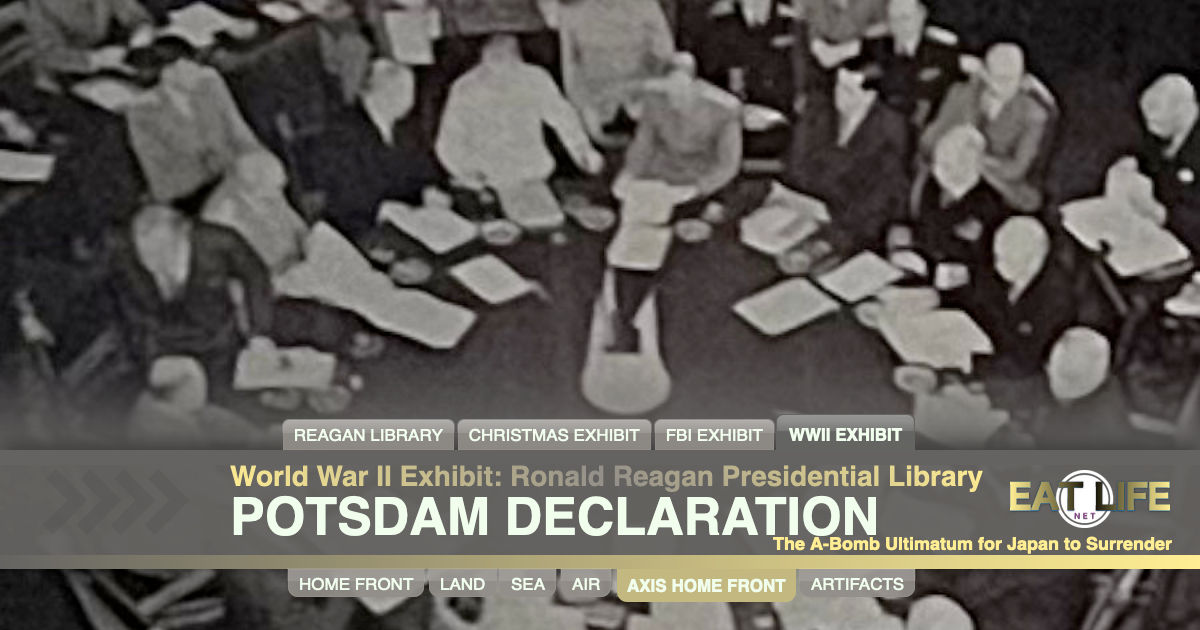
By July of 1945, the United States was focused on ending the war with Japan as soon as possible. A major component of this process was the Potsdam Conference. Convened in a suburb of Berlin at the manor of a former German crown prince, the conference was attended by Allied representatives of the United States, the United Kingdom, and the Soviet Union.
While still wanting to end the war quickly and vigorously, the Potsdam declaration noted that the Allied powers had no desire to destroy the nation of Japan or enslave its people. The terms of the surrender included the abdication of Japan's military government, while forcing it to rescind its claims to territory in the Pacific beyond the main islands of Honshu, Kyushu, Hokkaido, and Shikoku. It also asserted that there would be an Allied presence in Japan until it was demilitarized and established as a Western trading partner.
 The Japanese did not initially accept the terms of surrender offered in the Potsdam Declaration.
Many Japanese officials were reticent about the declaration due to its demand for "unconditional surrender."
This was seen as confirmation that surrender would result in the deposition and even execution of the revered Emperor Hirohito.
Such a possibility made Japanese acceptance of the declaration practically impossible.
The Japanese did not initially accept the terms of surrender offered in the Potsdam Declaration.
Many Japanese officials were reticent about the declaration due to its demand for "unconditional surrender."
This was seen as confirmation that surrender would result in the deposition and even execution of the revered Emperor Hirohito.
Such a possibility made Japanese acceptance of the declaration practically impossible.
To force the Japanese to surrender, the United States became the first and only nation to use nuclear weapons in combat, dropping atomic bombs on the Japanese cities of Hiroshima and Nagasaki within a week of the close of the Potsdam Conference on August 2, 1945.
Soon after, the Japanese agreed to an amended version of the Potsdam Declaration that came with assurances from Truman that the Emperor would be allowed to remain in power. World War II was officially over.
The events of the Potsdam Conference proved to have a far more lasting impact on the relationship between the United States and the Soviet Union. The relationship between the two countries had been tenuous throughout the war. That internal division was evident in the decision-making of the American officials who so desperately sought to avoid Soviet intervention in the war's Pacific Theater. The success of the Manhattan Project made the atomic bomb the most important bargaining chip in achieving that end.
President Harry S. Truman revealed to the world in a recorded message the use of the first atomic bomb as he was returning from the Potsdam Conference aboard the USS Augusta in August 1945.
WIKIPEDIAThe Potsdam Conference
It was held at Potsdam in the Soviet occupation zone from July 17 to August 2, 1945, to allow the three leading Allies to plan the postwar peace. The participants were the Soviet Union, the United Kingdom, and the United States. They were represented respectively by General Secretary Joseph Stalin, Prime Ministers Winston Churchill and Clement Attlee, and President Harry S. Truman. They gathered to decide how to administer Germany, which had agreed to an unconditional surrender nine weeks earlier. The goals of the conference also included establishing the postwar order, solving issues on the peace treaty, and countering the effects of the war.During the Conference, Truman was secretly informed that the Trinity test of the first atomic bomb on July 16 had been successful. He hinted to Stalin that the U.S. was about to use a new kind of weapon against the Japanese. Though this was the first time the Soviets had been officially given information about the atomic bomb, Stalin was already aware of the bomb project, having learned about it through espionage long before Truman did.
Key final decisions included the following:
- Germany would be divided into the four occupation zones (among the three powers and France) that had been agreed to earlier
- Germany's eastern border was to be shifted west to the Oder–Neisse line
- A Soviet-backed group was recognized as the legitimate government of Poland
- Vietnam was to be partitioned at the 16th parallel
- The Soviets also reaffirmed their Yalta promise to promptly launch an invasion of Japanese-held areas.
Views were also exchanged on a plethora of other questions. However, consideration of those matters was postponed into the Council of Foreign Ministers, which the conference established.
on 26 July, Churchill; Truman; and Chiang Kai-shek, Chairman of the Nationalist Government of China (the Soviet Union was not yet at war against Japan), issued the Potsdam Declaration, which outlined the terms of surrender for Japan during World War II in Asia.
Truman had mentioned an unspecified "powerful new weapon" to Stalin during the conference. Towards the end of the conference, on July 26, the Potsdam Declaration gave Japan an ultimatum to surrender unconditionally or meet "prompt and utter destruction", which did not mention the new bomb but promised that "it was not intended to enslave Japan". The Soviet Union was not involved in that declaration since it was still neutral in the war against Japan. Japanese Prime Minister Kantarō Suzuki did not respond, which was interpreted as a sign that the Japanese had ignored the ultimatum. As a result, the United States dropped atomic bombs on Hiroshima on 6 August and on Nagasaki on 9 August 1945. The justifications used were that both cities were legitimate military targets and that it was necessary to end the war swiftly and preserve American lives.
When Truman informed Stalin of the atomic bomb, he said that the United States "had a new weapon of unusual destructive force", but Stalin had full knowledge of the atomic bomb's development from Soviet spy networks inside the Manhattan Project and told Truman at the conference that he hoped Truman "would make good use of it against the Japanese."
History.comAt the Potsdam Conference
The leaders of the United States, Great Britain and the Soviet Union-the "Big Three" powers who had defeated Nazi Germany - met in the city of Potsdam near Berlin. Their meeting lasted from July 17 to August 2, 1945, during what was a crucial moment in defining the post-World War II balance of power.The summit also gave an early hint of the tensions that would develop between the U.S. and the Soviet Union, which eventually led to a Cold War struggle that lasted for more than four decades.
The conference was attended by U.S. President Harry S. Truman, Soviet leader Joseph Stalin and British Prime Minister Winston Churchill, who was abruptly replaced on July 26 by his successor Clement Attlee, after results of the British election were announced.
- The conference came just three months after Truman took over the presidency following the death of his predecessor, Franklin D. Roosevelt.
- Germany's fate after the war was an important topic of the conference. According to the U.S. State Department's history of the event, Stalin had pressured FDR at the previous Yalta Conference in February 1945 to force the defeated Germans to pay heavy postwar reparations, half of which would go to the Soviet Union. Roosevelt had agreed to that demand. But Truman, who was keenly aware that similar economic punishment inflicted upon the Germans after World War I had led to the rise of Adolf Hitler and Nazism, was determined not to make the same mistake.
- The Big Three worked out many of the details of the postwar order in the Potsdam Agreement, signed on August 1.
Potsdam Declaration
Another important purpose of the Potsdam Conference was to pressure Japan, which was still in the war. To that end, on July 26, the United States and Great Britain, along with China, issued the Potsdam Declaration, which threatened a massive aerial and naval attack and land invasion that would "strike the final blows upon Japan," unless the Japanese agreed to surrender.The declaration laid out the Allies' non-negotiable terms for peace, which included unconditional surrender and disarming of the Japanese military, occupation of Japan "until there is convincing proof that Japan's war-making power is destroyed" and trials for Japanese war criminals, and creation of a democratic system of government with freedom of speech and other rights for citizens.
In exchange, Japan would be allowed to maintain industries that were unrelated to war and have access to raw materials, and eventually would be permitted to resume international trade.
Just before the conference began, Truman got the secret news of the successful Trinity test of the atomic bomb by Manhattan Project scientists, and apparently decided to use that knowledge to give him a negotiating advantage over Stalin.
At the close of an afternoon meeting of July 24, Truman walked over to Stalin and told him quietly that the U.S. had developed "a new weapon of unusual destructive force," more powerful than any known bomb, and planned to use it soon unless Japan surrendered.
Probably to Truman's surprise, Stalin didn't seem too interested in the revelation. "All he said was that he was glad to hear it, and hoped we would make ‘good use of it against the Japanese,'" Truman later recalled. The reason behind Stalin's mild reaction was that he had at least two spies inside the Manhattan project and already knew about the U.S. atomic weapons program. The Soviet leader didn't budge from his negotiating positions.
Potsdam was the final time that leaders of the United States, Great Britain and the Soviet Union, who had maintained a tense alliance despite their differences during the war, would meet to discuss postwar cooperation.
WIKIPEDIAThe Potsdam Declaration
The Proclamation Defining Terms for Japanese Surrender
Statement that called for the surrender of all Japanese armed forces during World War II. On July 26, 1945, United States President Harry S. Truman, United Kingdom Prime Minister Winston Churchill, and Chairman of China Chiang Kai-shek issued the document, which outlined the terms of surrender for the Empire of Japan, as agreed upon at the Potsdam Conference.The ultimatum stated that, if Japan did not surrender, it would face "prompt and utter destruction."
On July 26, the United States, Britain, and China released the declaration announcing the terms for Japan's surrender, with the warning as an ultimatum: "We will not deviate from them. There are no alternatives. We shall brook no delay."
For Japan, the terms of the declaration specified:
- The elimination "for all time of the authority and influence of those who have deceived and misled the people of Japan into embarking on world conquest"
- The occupation of points in Japanese territory to be designated by the Allies
- That the Japanese sovereignty shall be limited to the islands of Honshu, Hokkaido, Kyushu, Shikoku, and such minor islands as we determine, (as had been announced in the Cairo Declaration in 1943)
- That the Japanese military forces, after being completely disarmed, shall be permitted to return to their homes with the opportunity to lead peaceful and productive lives
- That "we do not intend that the Japanese shall be enslaved as a race or destroyed as a nation, but stern justice shall be meted out to all war criminals, including those who have visited cruelties upon our prisoners
On the other hand, the declaration offered:
- The Japanese Government shall remove all obstacles to the revival and strengthening of democratic tendencies among the Japanese people. Freedom of speech, of religion, and of thought, as well as respect for the fundamental human rights shall be established.
- Japan shall be permitted to maintain such industries as will sustain her economy and permit the exaction of just reparations in kind, but not those which would enable her to rearm for war. To this end, access to, as distinguished from control of, raw materials shall be permitted. Eventual Japanese participation in world trade relations shall be permitted.
- The occupying forces of the Allies shall be withdrawn from Japan as soon as these objectives have been accomplished and there has been established, in accordance with the freely expressed will of the Japanese people, a peacefully inclined and responsible government.
The mention of "unconditional surrender" came at the end of the declaration:
Potsdam DeclarationWe call upon the government of Japan to proclaim now the unconditional surrender of all Japanese armed forces, and to provide proper and adequate assurances of their good faith in such action. The alternative for Japan is prompt and utter destruction.Contrary to what had been intended at its conception, which was to disenfranchise the Japanese leadership so that the people would accept a mediated transition, the declaration made no direct mention of the Japanese emperor at all. However, it insisted that "the authority and influence of those who have deceived and misled the people of Japan into embarking on world conquest must be eliminated for all time." Allied intentions on issues of utmost importance to the Japanese, including the extent and number of Allied "occupation points," the fate of Japan's minor islands, and the extent to which the Allies planned to "control" Japan's "raw materials," as well as whether Hirohito was to be regarded as one of those who had "misled the people of Japan" or he might potentially become part of "a peacefully inclined and responsible government," were thus left unstated, which essentially made it a blank check for the Allies.
The "prompt and utter destruction" clause has been interpreted as a veiled warning about American possession of the atomic bomb, which had been successfully tested in New Mexico on July 16, 1945, the day before the opening of the conference. Although the document warned of further destruction like the Operation Meetinghouse raid on Tokyo and other carpet bombing of Japanese cities, it did not mention anything about the atomic bomb.











